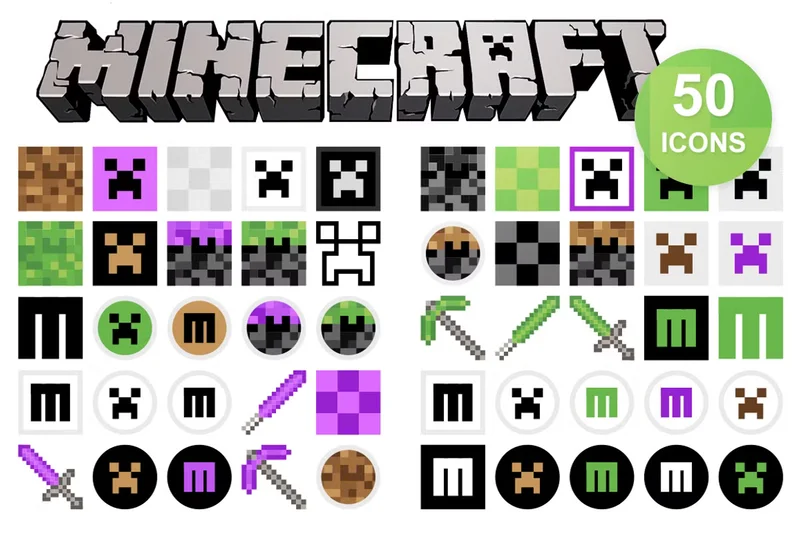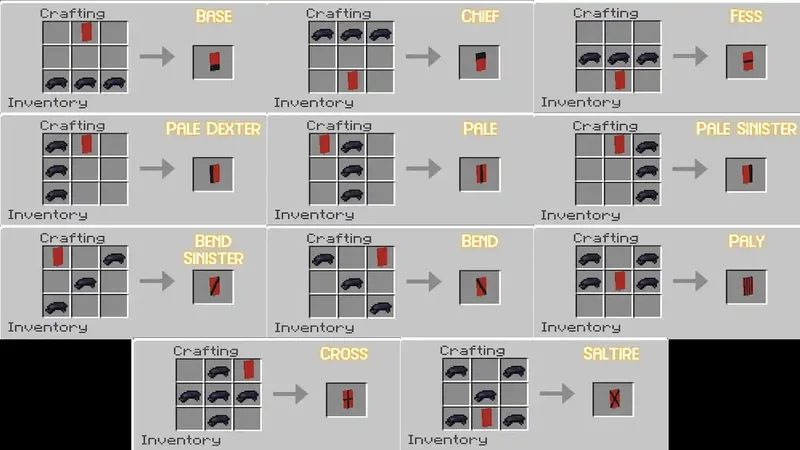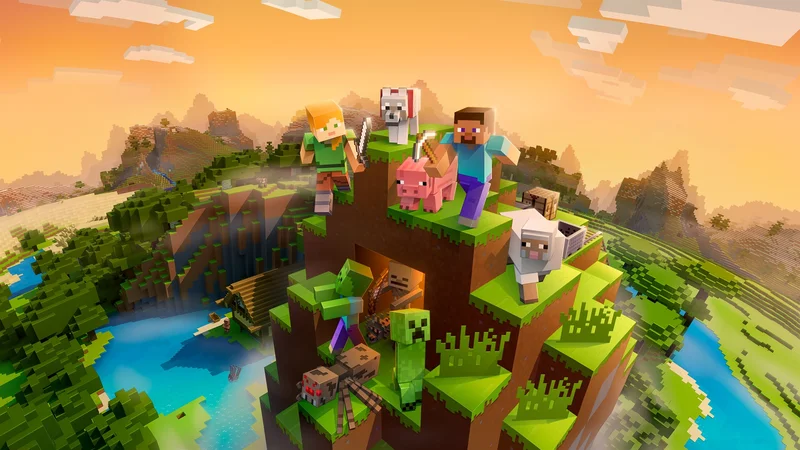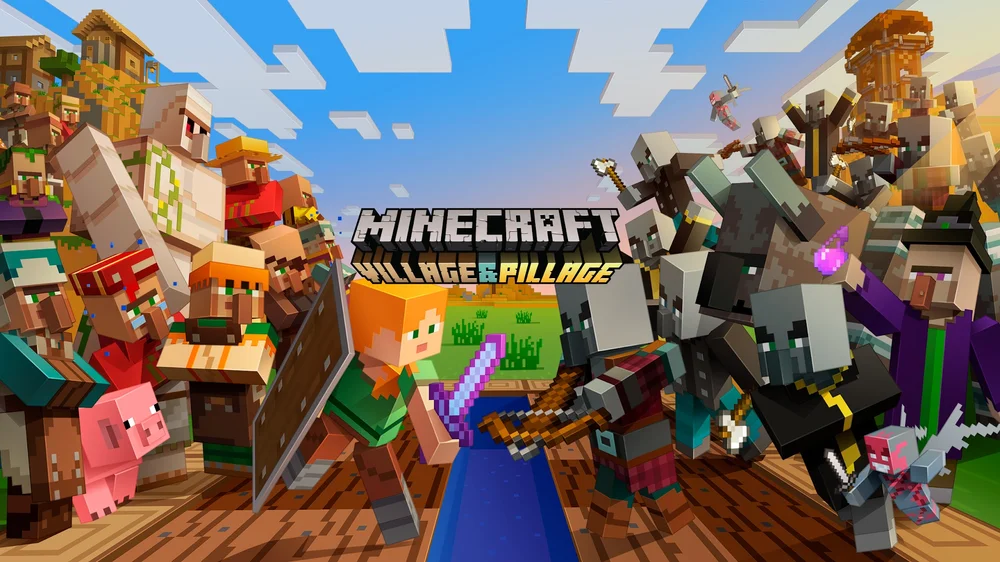The well-known sandbox game Minecraft (2009) allows users to explore, construct, and survive in a pixelated environment. Using game icons and banners to customise your experience is one of the game’s most awesome features.
Regardless of their complexity, these designs serve to embody your style and adventures. Gamers can design original symbols that give their world life, such as serene landscapes or ferocious dragons.
Icons and banners for the 2009 game Minecraft provide countless creative options. They give each creation a personal touch, giving your Minecraft world a genuinely distinctive feel.
Whether you’re building in creative mode or surviving in the wild, these designs enhance gameplay and connect players within the Minecraft community. Let’s explore how these game icons and banners have shaped the Minecraft experience!
The Basics of Minecraft Banners
Minecraft banners are a fun and creative way for players to express themselves within the game. Made from wool and a stick, banners take on a tall, flag-like shape that can be customised with a wide range of patterns and colours.
These customizable designs allow players to decorate their surroundings, mark important locations, or even communicate messages to others in multiplayer worlds.
To create a banner, players start with a blank canvas, which typically reflects the colour of the wool used. Using dyes and a loom, players can add intricate patterns, symbols, and even letters, offering a high degree of personalization.
The loom, introduced as a crafting station, simplifies the process of applying these designs, making banner customization accessible to everyone.
Banners are commonly used to mark territories, decorate buildings, or signify a player’s presence in the game.
They add a layer of uniqueness and creativity to the Minecraft world, enriching the experience and allowing players to leave their mark on the ever-expanding landscape.
Minecraft’s Development Over the Years
Since its launch in 2009, Minecraft has evolved significantly with numerous updates and expansions, introducing new features, biomes, and gameplay mechanics. From the introduction of new mobs to the addition of complex redstone mechanics, the game has constantly grown and adapted.
However, one aspect that has remained a constant throughout Minecraft’s development is its iconic visual style. This style includes the game’s distinctive blocky graphics, memorable game icons, and, of course, customizable banners.
As Minecraft expanded, so did the creative possibilities for players. Banners, in particular, became a way for players to showcase their personal touch in the game.
Whether used to decorate a fortress, signal a faction’s territory, or simply express creativity, the banner system remained an essential part of the game’s identity.
These small but impactful design elements allowed players to not only leave their mark in the world but also reflect the evolving world of Minecraft itself.
Exploring the Diversity of Banner Designs
The only thing limiting the number of banner designs in Minecraft is the players’ creativity. The potential for making one-of-a-kind banners is incredible, with over 16 million color choices and several pattern layers. There are endless creative options available, ranging from straightforward borders and stripes to more complex patterns like skulls, flowers, and crossbones.
A variety of methods and materials can be used to create banners in Minecraft. The uniqueness of the design can be further enhanced by players adding specific patterns using natural elements like vines or creeper heads. This gives each banner a unique touch and adds another level of complexity to banner crafting.
The possibilities for banner designs have increased with the addition of the loom in recent upgrades. The loom opens up a greater range of design possibilities and facilitates the creation of increasingly intricate patterns. Banner crafting has been transformed by this tool, which enables gamers to try out more complex and elaborate designs that were previously challenging to do.
The diversity of banner designs is also greatly increased by the Minecraft community. Players may recreate everything from national flags to pop culture allusions thanks to the abundance of tutorials and design blueprints available on social media, online forums, and sharing sites. This attitude of cooperation guarantees that the potential for banner designs keeps expanding, demonstrating the limitless inventiveness of the Minecraft community.

What Are Minecraft Game Icons?
The visual representations of in-game objects, bricks, and entities that players come across during gameplay are known as Minecraft game icons. By serving as a kind of visual language, these icons let players identify and connect particular objects in the game environment with ease. Each icon is made to instantly identify the object it symbolizes, whether it’s a pickaxe, a block of soil, or a mob like a creeper.
These game icons serve more than just an aesthetic purpose—they are essential for improving the overall user experience.
By providing clear and simple images, these icons make it easier for players to navigate Minecraft’s complex inventory system and quickly identify objects and tools in the game’s interface.
This visual clarity enhanced gameplay, allowing players to focus on exploration, building, and survival without getting bogged down by unnecessary confusion.
Types of Icons in Minecraft
Minecraft features a variety of icons, each designed to represent different categories of objects, items, and entities within the game. These icons help players navigate and interact with the game world efficiently. Here are the main types of icons found in Minecraft:
Block Icons: These icons represent the various building blocks available in the game, such as stone, wood, ores, and more. Block icons are essential for players when constructing buildings, crafting structures, or mining resources.
Item Icons: These icons represent tools, weapons, food, and other collectible items that players can craft or gather during their adventures. From pickaxes and swords to apples and potions, item icons help players quickly identify what they’re working with in their inventory.
Entity Icons: These icons depict the creatures and mobs that players encounter throughout the game. Hostile mobs, like zombies and skeletons, are shown alongside passive mobs, such as cows and sheep. Entity icons make it easier for players to identify and engage with the various creatures that populate the Minecraft world.
GUI Icons: These icons are used in Minecraft’s user interface (GUI), representing actions, settings, and menus. Whether it’s accessing the crafting menu, managing inventory, or adjusting game settings, GUI icons are crucial for streamlining the player’s experience and making the game more accessible.
Each of these icons plays a vital role in helping players interact with Minecraft’s vast and dynamic world, ensuring smooth gameplay and an enjoyable experience.

Crafting a Minecraft Banner
Crafting a Minecraft banner is a simple yet creative process that allows players to design their own unique flags to express themselves in the game. Players only need sticks and wool, two basic items, to create a banner.
These ingredients create a tall, flag-like structure that serves as a blank canvas for customization.
Once you have crafted the basic banner, the real fun begins. Using dyes and a loom, players can add vibrant colours and intricate patterns to their banner.
The loom, introduced in recent updates, makes it easier to apply various designs, allowing for more detailed and creative patterns.
With a wide array of colours and design options, players can create everything from simple geometric shapes to complex images, such as skulls, hearts, or even custom symbols.
Minecraft banners are a flexible form of self-expression, with endless possibilities for players to showcase their style, mark territories, or decorate their builds.
Whether you’re crafting banners for a personal project or to share with others in multiplayer servers, the process of designing banners adds a unique layer of creativity to the Minecraft experience.
Banner Customization Tools and Resources
For players looking to explore more advanced banner customization, Minecraft offers several in-game tools and external resources to enhance the crafting experience.
The primary tool for creating and customising banners in Minecraft is the loom. This user-friendly block simplifies the process of applying intricate patterns and designs to banners, making it an essential item for any player interested in decorating their world.
The loom allows for easy layering of different patterns, making it easier to create detailed and personalised banners.
In addition to the loom, dyes are crucial for adding colour to your banners. Minecraft offers a wide variety of dyes made from in-game materials such as flowers, plants, and even mobs.
These dyes give players the freedom to choose from a spectrum of vibrant hues, enabling endless customization possibilities for banner designs.
Beyond the in-game tools, the Minecraft community has developed many helpful external resources to assist in banner crafting.
Websites like Needcoolshoes feature banner crafting simulators, allowing players to experiment with different patterns and colour combinations before they start crafting in the game.
These sites often include user-generated content such as design templates, ideas, and tutorials, offering inspiration for both new and experienced players.
For even more in-depth guidance, platforms like YouTube and Minecraft forums are packed with tutorials and walkthroughs from the Minecraft community. These resources are perfect for discovering new techniques, creative ideas, and step-by-step instructions on banner design.
By using these tools and resources, players can elevate their banner crafting skills and bring their creative visions to life, enriching their Minecraft experience with personalised, eye-catching designs.

Community-Created Banners and Their Impact
The vibrant Minecraft community has played a pivotal role in enriching the game, particularly through its contributions to banner designs.
With an infinite number of designs to suit every taste and inclination, community-made banners are a monument to the players’ inventiveness and originality. These banners test the boundaries of what is feasible in the crafting system of Minecraft, ranging from delicate, simple designs to elaborate pieces of art.
By sharing their designs online, players have fostered a collaborative environment that encourages innovation.
Minecraft’s banner crafting system, while flexible, is made even more powerful by the community’s ability to transcend its basic mechanics, creating designs that reference pop culture, history, and other creative themes.
These shared creations inspire others to experiment with new techniques and explore the full potential of banner artistry.
Community-created banners do more than just enhance the visual appeal of the game—they also enrich the player experience by telling stories, expressing ideas, and celebrating shared moments.
Each banner crafted by the community adds a layer of individuality to the Minecraft world, making each server, build, and territory feel unique and personal.
The impact of these designs extends beyond aesthetics. They help cultivate a sense of belonging within the Minecraft community, as players exchange tips, showcase their creations, and inspire each other.
This collaborative spirit not only strengthens the bonds between players but also fosters a generous and supportive social environment, making Minecraft a game where creativity and connection thrive together.
Iconic Minecraft Characters
Minecraft is filled with memorable characters, both playable and hostile, each contributing to the game’s unique identity. Some of these iconic figures have become synonymous with the game itself, playing key roles in shaping the Minecraft experience.
Steve and Alex: Known as the faces of Minecraft, Steve and Alex are the default player characters. These figures stand in for the player in the game, and their straightforward, blocky design has come to symbolize the imaginative and vast universe of Minecraft. All experiences take place through Steve and Alex, the avatars that players use whether they are exploring, constructing, or surviving.
Creeper: Perhaps the most famous mob in Minecraft, the Creeper is an infamous hostile character with a distinct green body and a mischievous expression. Known for its explosive nature, the Creeper has become a beloved yet feared part of the game, often associated with surprise explosions and unexpected encounters. Its iconic design and behaviour have made it a standout character in the Minecraft universe.
Enderman: The Enderman is a tall, slender mob known for its eerie appearance and mysterious behaviour. With glowing purple eyes and the ability to teleport and manipulate blocks, the Enderman is both a fascinating and unsettling presence in Minecraft. Its unique traits, along with its otherworldly demeanour, make it a memorable character that players encounter in various parts of the game world.
These iconic Minecraft characters, from the player avatars to the various mobs, have become integral to the game’s culture.
Each one adds a layer of personality and excitement, helping to define the world of Minecraft and leaving a lasting impact on its community.
How Minecraft Game Icons Influence Gameplay?
Minecraft game icons are essential to the overall gameplay experience, playing a vital role in how players interact with the game world.
These icons provide clear visual cues that help players easily identify and navigate the different elements of the game, such as blocks, items, mobs, and tools.
This simple yet effective use of icons streamlines gameplay, allowing players to focus on the core aspects of Minecraft, like exploration, building, and survival, without being distracted by complex menus or unclear graphics.
The recognizability of Minecraft game icons also contributes to the game’s accessibility. Icons make it easier for both new and experienced players to understand the game’s vast systems at a glance, whether it’s navigating the inventory, recognizing important items, or managing resources.
The clear and intuitive design of these icons eliminates the need for constant explanations, enabling players to jump straight into their adventures.
Beyond functionality, Minecraft’s game icons have become cultural symbols, influencing the community’s shared experiences.
Iconic characters like the Creeper and the Enderman are not only central to gameplay but have also sparked a wave of memes, fan art, and cultural references. These recognizable figures have helped build a strong, connected Minecraft community, turning the game into a global phenomenon and solidifying its place in pop culture.
Using Minecraft Banners
In addition to the iconic game elements, Minecraft offers a unique banner system that allows players to create and customise their own heraldic designs.
These banners act as visual representations of a player’s identity, achievements, or affiliations, giving players the opportunity to express their creativity and leave their mark on the game world.
There are numerous applications for banners. They are frequently displayed by players to indicate key sites, like their base or a noteworthy build, or to represent their faction or group on multiplayer servers.
Banners also serve as a form of self-expression, showcasing unique designs that reflect a player’s personal style or commemorate an event within the game.
The versatility of banners allows for endless customization. Players can experiment with different colours, patterns, and symbols, using dyes and the loom to create complex and meaningful designs.
Whether they are creating a simple pattern or a banner that represents an entire community, Minecraft’s banner system adds a layer of depth and personalization to the game, making each player’s world feel unique and their journey truly their own.
Crafting and Customization Minecraft Banners
In Minecraft, banners offer players a unique way to showcase their creativity and personalise their in-game experience.
Crafting a banner begins with basic materials like wool and sticks, which are combined to create a blank banner. Once the banner is crafted, the real fun begins as players can use a variety of dyes, patterns, and symbols to customise it.
The game features a wide range of dyes that can be obtained from plants, mobs, and other resources, offering vibrant colours to work with. Players can then apply these dyes to create simple designs or intricate patterns.
The customization process is further enhanced by the ability to layer different patterns on top of one another. These patterns include stripes, borders, shapes like circles or triangles, and even more detailed designs like skulls, trees, or creepers.
This system allows players to express their personal style, whether they want a banner that represents their in-game adventures, a favourite colour scheme, or a design that matches the theme of a specific building or settlement.
Whether it’s a majestic castle or a humble village, banners can become a central part of a player’s world, marking important locations or showing off accomplishments. The flexibility in crafting and customising banners truly makes them a standout feature of Minecraft, encouraging endless possibilities for personalization.

Designing Minecraft Banners
The design of Minecraft banners is a creative process that allows players to combine predefined patterns and symbols in endless ways.
While the game provides a variety of built-in designs, the true magic happens when players experiment with these elements, layering and arranging them to create something truly unique.
The banner system offers a range of basic shapes and symbols, such as stripes, crosses, gradients, and geometric patterns.
Players can mix and match these elements, adjusting their placement and colour to produce intricate designs that reflect personal creativity or in-game themes.
For example, a player might start with a simple colour gradient as a background, then layer on a series of symbols, like a skull, animal motif, or abstract shapes, to build a complex, multi-layered design.
This flexibility has led to some amazing creations, from flags representing fractions or kingdoms, to banners that serve as works of art or symbols of achievement. Some players even go as far as to design banners that mimic real-world flags or iconic symbols from other media.
The ability to fine-tune designs by combining various colours, shapes, and patterns means that no two banners need to be alike, making each banner a personal expression of the player’s style and imagination.
Overall, designing Minecraft banners is a fun and rewarding way to leave a mark on the game world.
The combination of simple elements and the creativity of the player results in banners that become more than just decorative items – they become symbols of identity and artistic achievement within the vast world of Minecraft.
Tips for Creating Minecraft Banners
Creating unique and visually striking Minecraft banners requires a mix of creativity, experimentation, and thoughtful design. Here are some essential tips to help you craft banners that stand out in your Minecraft world:
- Experiment with Layering: One of the most powerful tools in banner design is layering. By combining multiple patterns and symbols, you can add depth and complexity to your banner. Start with a basic background design, and then layer additional patterns, such as stripes, crosses, or shapes, on top. This can create a more dynamic and intricate appearance, giving your banner a polished, professional look.
- Utilise Colour Theory: Colours play a significant role in banner design, not only for aesthetic appeal but also for the meanings they carry. Consider the emotional and cultural associations of different colours when selecting your colour scheme. For instance, red might symbolise strength or danger, while blue could represent calmness or loyalty. Choosing complementary colours or creating a gradient effect can also make your banner visually striking.
- Incorporate Symbolism: Banners are more than just decorative pieces; they can carry meaning. Think about using symbols or motifs that hold personal or cultural significance. For example, a banner featuring a dragon symbol might represent bravery, while a banner with a heart could symbolise love or unity. Adding meaningful symbols will make your banner not only unique but also meaningful to you or your community.
- Think About Composition: A well-balanced design is crucial for a visually appealing banner. Pay attention to how patterns and symbols are arranged within the banner’s space. Ensure that the elements are evenly distributed to avoid a cluttered or overly busy design. A balanced composition will make your banner easier to read and more aesthetically pleasing.
By combining these tips—layering, colour selection, symbolism, and composition—you can design banners that are both visually captivating and rich with meaning. Let your imagination run wild and experiment with different elements to create banners that truly define your Minecraft world.
Conclusion
Minecraft banners have become a powerful way for players to express their creativity and personal style within the game.
By crafting and customising banners with different patterns, colours, and symbols, players can create unique designs that reflect their in-game experiences.
The ability to experiment with layering, colour theory, and meaningful symbols adds depth to banner designs, making them more than just decorative elements.
As players continue to explore the possibilities of Minecraft banners, they not only enhance their worlds visually but also bring new levels of personal expression and identity to the game.
Banners have truly become an iconic feature of Minecraft, offering endless opportunities for creative design and customization.
Frequently Asked Questions
1. How do you craft a banner in Minecraft?
To craft a banner in Minecraft, you need 6 pieces of wool and 1 stick. Place the wool in two vertical rows (3 wool in each row) and the stick in the centre bottom slot of the crafting table.
2. How can I customise my Minecraft banner?
You can customise your banner by adding dyes and patterns. Use a crafting table or a loom to combine dyes with the banner, creating various designs and symbols that suit your style.
3. What are some common designs for Minecraft banners?
Common Minecraft banner designs include stripes, crosses, gradients, and simple shapes like stars or skulls. Players also create banners to represent flags or symbols from other media.
4. Can I use Minecraft banners for decoration?
Yes! Minecraft banners are often used for decoration in homes, castles, villages, and other structures. They can also mark important locations or represent in-game factions.
5. Are there any tips for creating a good Minecraft banner?
Yes! To create a standout Minecraft banner, experiment with layering different patterns, use colours with meaningful significance, and think about the overall composition of your design. Balance your elements to make your banner visually appealing.
6. Can I use Minecraft banners in multiplayer?
Yes! Minecraft banners can be shared in multiplayer worlds, allowing players to display their custom designs and use them as part of their in-game identity or team symbols.
Also Read: How to Draw a Dragon Like Drawing:5z_Boyjkm98= Dragon: A Step-by-Step Guide


